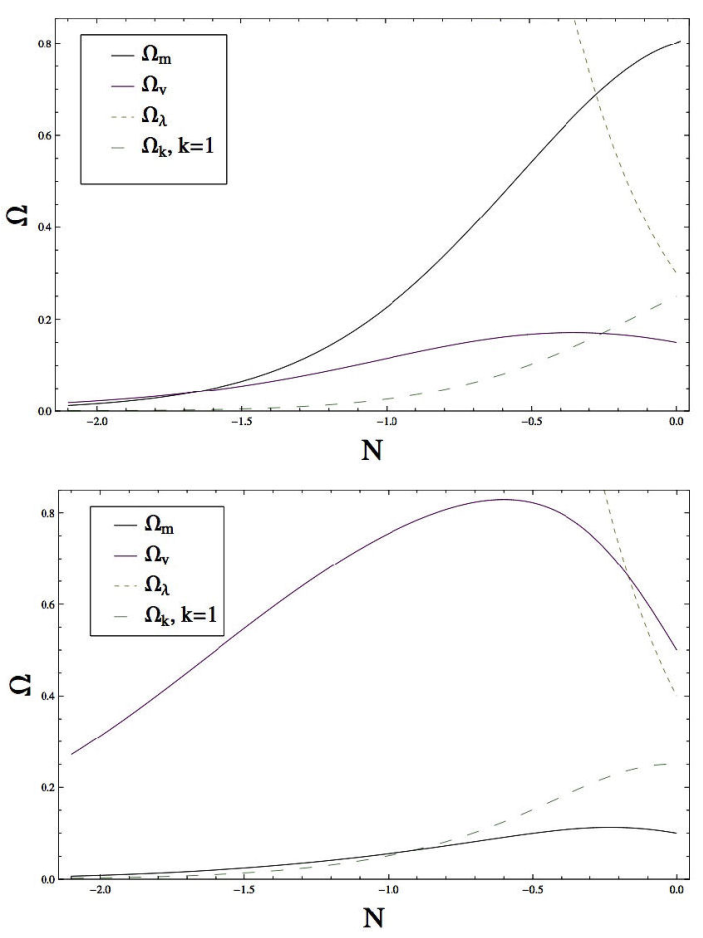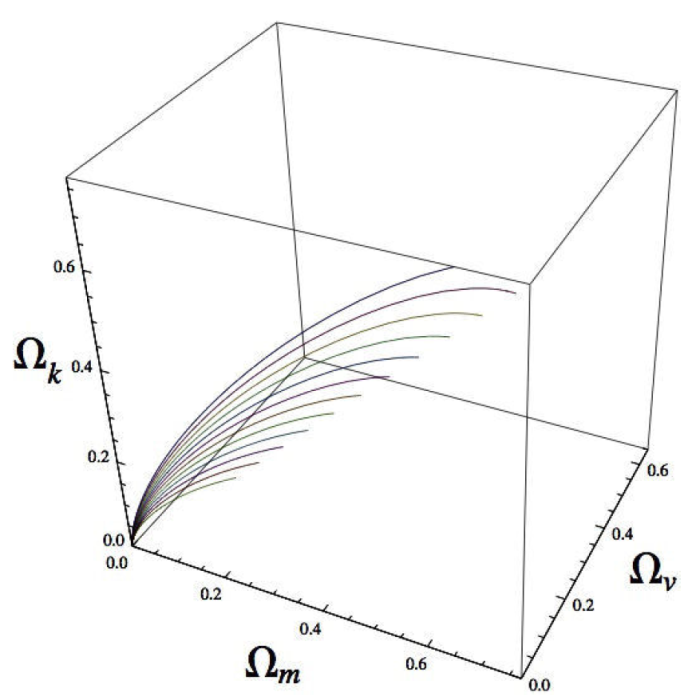PACS: 04.50.-h; 04.40.Dg
1.Introduction
Brane-world theory, is one of the most promising extensions to General Relativity (GR) due of their natural ability to solve fundamental problems in physics with unprecedented success1,2,3. One of the problems addressed in this context, is for example, the hierarchy problem which is solved by the insertion of one or two 4-dimensional branes in a 5-dimensional bulk with Anti d’Sitter (AdS) geometry (see for example) or a most complex bulk geometry 6; due to this particular topology, the gravity is weakened as it approaches to our 4-dimensional manifold (brane), solving in a natural way the problem of hierarchy 5,6. It is important to remark that this new topology generates modifications in Einstein’s equations with the presence of second order term in the energy-momentum tensor, the presence of bulk matter and the existence of nonlocal terms due to the 5-dimensional Weyl tensor 6.
From here, it is noteworthy to remark the contributions to cosmology7,8,9,10,11 and astrophysics12,13,14,15,16,17,18,19, establishing new dynamics and alternative solutions to for example, the stellar stability, dark energy and dark matter problems20,21,22,23,24,25,26. In cosmological context, it is possible to find quadratic terms and non local terms, which are relevant at high energies, providing new dynamic in inflationary models27 among others cosmological studies. Also we have new astrophysical dynamics from the brane-world point of view, where it is possible to explore the stability bounds generated by the presence of extra dimensions12,17,18, or the behavior of a star with a polytropic Equation of State (EoS)28.
There have been advances in this approach, where it is studied the stellar stability imposing different exterior conditions 12, there are also studies where it is considered a star with constant energy density in which is demonstrated that Schwarzschild exterior is the extreme case possible(see for example 17), also it is demonstrated the minimal setup to obtain a stellar configuration with the initial conditions of any EoS and with a Schwarzschild exterior17. As a counterpart, it is possible to study stellar collapse using the Snyder-Oppenheimer (SO) model through a no-go theorem in order to explore whether it is possible to maintain a Schwarzschild exterior type15. In the same vein, other studies focus in the gravitational collapse and black hole formation and evolution29 as well as the curvature corrections in the stellar collapse30.
Before we start, let us mention here some experimental constraints on braneworld models, most of them about the so-called brane tension, λ, which appears explicitly as a free parameter in the corrections of the gravitational equations mentioned above. As a first example we have the measurements on the deviations from Newton’s law of the gravitational interaction at small distances. It is reported that no deviation is observed for distances
Based in this background, this paper is dedicated to study the SO collapse in brane-world point of view through the theory of dynamical systems. We follow the standard procedure35 and it is extended to the case of branes with the aim of delve the behavior of the various components of the star at different stages of collapse, showing the critical points, stability and saddle points, remarking the advantage of this method to describe the dynamic of the star in its final stages36,37.
This paper is organized as follows: in Sec. 2 we show the mathematical formalism necessary for the study of brane theory. In Sec. 3 we explore the model of SO collapse in brane context, performance the results through a numerical analysis. Finally in Sec. 4 we discuss our results obtained throughout the paper. Henceforth we use units in which
2. Mathematical Background
Let us start by writing the equations of motion for stellar stability in a brane embedded in a 5D bulk according to the RSII model [6]. Following an appropriate computation (for details see 1,6), it is possible to demonstrate that the modified 4D Einstein’s equation can be written as
here
For simplicity, we will not consider bulk matter and then
where
3. Snyder-Oppenheimer collapse in branes
We turn our attention to the gravitational collapse of a ball made of dust, and look for the dynamic caused by the brane corrections15. Our arguments below will follow the simple assumptions we have made so far about the brane corrections on the 4-dimensional gravitational equations of motion. To begin with, we find it convenient to write the physical basis of a comoving coordinate system in the form:
For practical porpoises, it is possible rewrite Eq. in the form:
then, the non-null terms are:
where dots represents derivative with respect to t and primes represents derivatives with respect to
being
Under the argument that we are still free to redefine the radial coordinate as an arbitrary function of
where prime denotes derivative with respect to
here
here the dot represents derivative with respect to t and we define
Notice that in the GR regime (
where
3.1. Dynamical Analysis
To complement this study, we analyze the equation of motion from the metric element(9), where the stellar components evolve during the collapse:
where
subject to the Friedman condition
The dynamical system can be written as:
where now, the primes denote derivative with respect to the e-foldings (
which can be obtained from Eq.(13) . From conditions (14) and (15), it is enough to investigate the flow of (16) defined in the space phase
where it is reduced the above condition due that we assume
Before to start, we establish two important limits: The first one, is the low energy limit where GR is recovered; in this case we have that
Returning to our analysis, Eqs.(16a)-(17) are readily soluble analytically, under the assumption k=0 due to the spherical geometry of the stellar configuration. The results are shown in Fig. 1. In the first case (Fig. 1 Top) we have that the initial conditions imposed are:

Figure 1 Phase space of the system (16a)-(16b), for the spherical geometry k = 1. (Top) Here we assume dominance of baryonic density parameter in comparison with the other components, as expected in a real stellar configuration. It is shown the matter, Weyl, brane tension and curvature terms during the evolution of collapse of the star. Notice how the high energy term
It is important to notice, how Fig. 1 show that the brane term
To complement our study realized through this section, we analyze the equilibrium points and eigenvalues associated to Eqs.(16) and (16b) in order to obtain important information about the collapse behavior. It is possible to define the equation of critical points as:
Table I Critical points for the system (16a) and (16b). From left to right, the columns read: Point, coordinates, existence, eigenvalues and stability.

In order to obtain information about attractors, saddle points and others, we found the eigenvalues associated with the Jacobian matrix . Table I summarize the eigenvalues associated with this particular model and establish the conditions of the eigenvalues existence (see the middle part of Table I). Our results remark the existence of saddle-like points in dynamics which represents unstable manifolds, being notorious in Figs. 2 which are phase portrait of Eqs.(16a)-(16b).

Figure 2 Phase portrait of Eqs. (16a)-(16b). (Top) As initial conditions, we fix the value of the matter density parameter at
Figures were computed under the following Initial conditions: In Fig. 2 top we fix the value of the matter density parameter at
4. Discussion
In this paper we implement a roboust analysis of the SO collapse in the background of branes showing the new terms that will play a role in the dynamic of collapse of a star. We start with the equation of motion for SO collapse which is shown in Eq. (11) and solved analytically for the most general case where branes play an important role, never losing sigh that Eq. (11) and Eq. (11) converge to GR in the appropriate limit
Similar analysis was conducted from the point of view of dynamical systems in order to study the dynamics of the different components of the star. In this case, we focused on the matter components (dust), the brane terms thats grows proportional to
To complement, we realize the phase portrait of Eqs.(16a)-(16b) (see Figs. 2 and 3) assuming different initial conditions with the aim of prove the behavior under different conditions. The mathematical and numerical analysis show saddle points which are unstable in the dynamics, noticing that the presence of non-local terms generates the discontinuity presented in Figs. 2. From Fig. 3 the plot is only restricted to the plane
As a final note, we emphasize that the procedure can be replicated for other classes of stars that may include the presence of polytropic matter or with other most general focuses and whose solutions may also require extra numerical analysis. However this is ongoing research that will be presented elsewhere.











 nueva página del texto (beta)
nueva página del texto (beta)



